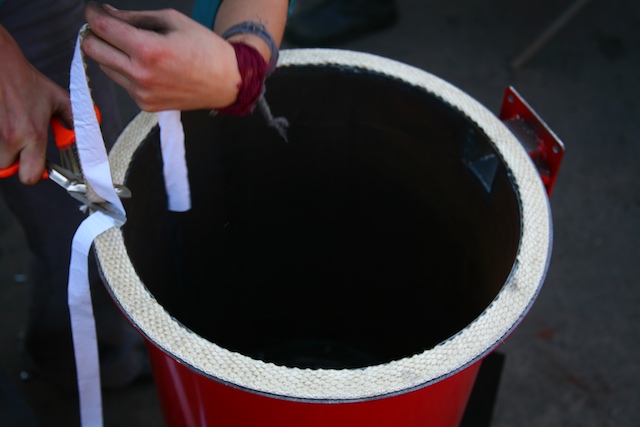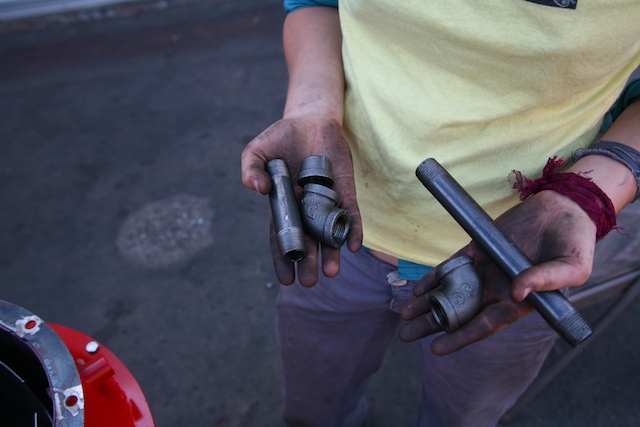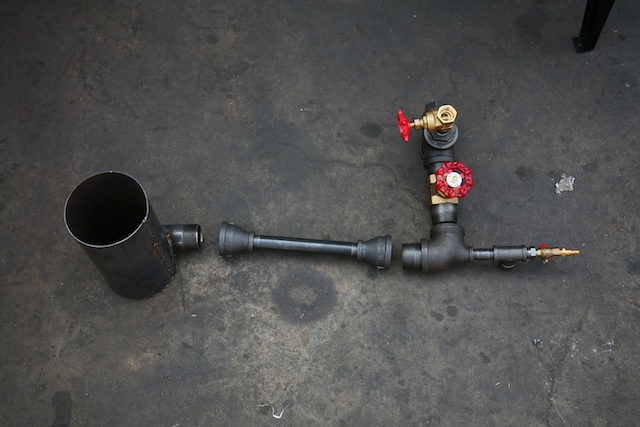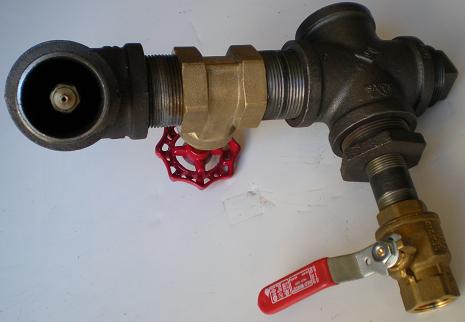return to How to Build and Run the GEK Gasifier
Assembly Instructions for the GEK v3.0 & v3.5 Base Unit
Table of Contents:
I) Intro
II) Tools Needed
1. Gas Cowling
2. Downdraft Reactor Insert
3. Cyclone and Filter
4. Ejector Venturi System
5. Manometer
I) Introduction
All these parts are pictured below. This is what you should have received with the Level IV kit, or built via your own efforts.


While assembling the various vessels, be sure to remember these common standards used throughout the GEK kit:
-When tightening bolts follow same pattern as tightening lug nuts on your car. Stagger tightening, don't go around in order. This will keep a good air tight seal.
II) Useful Tools for Assembly:
-
1/2" wrench or crescent wrench
-
1/2" sockets for socket wrench or (ideally) cordless drill/impact driver and drill to socket adapter\
-
9/16" wrench or socket or crescent wrench (for leg nuts)
-
Two from the following list (for plumbing):
- >2" Monkey Wrench
- Channel locks
- Vise
-
Utility knife
-
Allen (hex) key set (for stirrer motor)
-
Flathead screwdriver
1. Gas Cowling Assembly
A) Attach bottom plate
- Note: The v4 GEK bottom plate does not have a center rotation hole and bushing, as we have moved to a side shake grate instead of a center rotary grate.
- Use the fiberglass tape on the bottom lid of the reactor. This will cover your bolt holes so you will need to ream them out with something, a screw driver or a round file works good. After you have the bolt holes in the tape, apply a bead of the high temp mortar on top of the ceramic gasket clay.
- Lay bottom plate on so bushing for ash grate assembly is on the outside of the unit.
- Bolt on with 5/16 bolts.



B) Attach Legs:
- Turn Cowling upside down.
- Place rocket legs on the protruding studs, and tighten bolts. The legs come with the mount tabs bent in two different directions. Separate and install these accordingly to create leg symmetry between left and right sides of the gas cowling.


C) Add Ash Port Lid:
- While the gas cowling is upside down, place two rows of clay weather stripping onto cowling around circumference of ash port hole, on the inside of the bolts. Screw on wing nuts, hand tight.
- Turn upright.


D) Insert Ash Grate:
- Note: if you have the v3.5 and earlier, refer to the assembly instructions for the rotary ash grate.
- Obtain the threaded legs for the grate support ring. Thread them into the welded bolts on the grate support. These will allow adjustment of the height of the grate for experimentation. Make sure the grate support is even on the feet.
- Place the grate onto the grate support inside the reactor. Thread the grate bar through the side door on to the grate.
- The fiberglass insulation (Step E) will lay on the grate.
- Attach the side door on the cowling port. Depending on the desired height of the grate, cap the bottom 2'' ash port bung along with two of the 3/4'' bungs. Add the reducer and brass compression fitting onto the port door, make sure the ash grate support feet are at a height that the grate rod fits through the compression fitting on the door without jamming.




E) Insert Insulation:
- Starting with version 3.5, there is an insulation insert for the gas cowling. This consists of thin fiberglass sheet insulation and a stainless steel sheet tube which holds this against the wall of the gas cowling.
- Be sure to wear gloves, the insulation is currently of fiberglass material.
- Roll the insulation material to the outer edge of the inside of the gas cowling.
- It will sit above the bolt heads that are welded inside for the rocket legs, and the top of the insulation will line up with the bottom of the square gas outlet.
- The stainless steel insulating jacket will go into the gas cowling up against the fiberglass insulation, line the hole in the insulating jacket with the 1/2 inch bung on the outside of the gas cowling.
- Use the small sheet metal screws to hold the ss tube expanded out against the gas cowling walls. There are three different locations for screws, each with 3 different length holes. Use the holes which push the gas cowling outward as much as possible.
- Note: If you are upgrading to add the stainless steel insulation to a previous version of the GEK, you may need to trim the edges of the grate enough so that the stainless steel insulation will fit in between the gas cowling and the grate. We have changed the grate dimension to account for this spacing in the middle of our v3.0 shipments.
- Cut out the holes on the fiberglass insulation where they line up on the stainless steal jacket. Make sure the fiberglass insulation is not covering up the gas out port or the 1/2'' pressure port. The 1.5'' bung on the outside of the cowling can be covered up if it is not being used.



2. Downdraft Reactor Insert Assembly
A) Attach Gas Lines:
- Turn insert upside down.
- Tighten one gas line into elbow coupling.
- Bend clockwise, around the outside of the next coupling, continue around to the second coupling then bend down and start wrapping clock wise and down around insert. Keep wrapping until its obvious which attachment it goes to in the mid flange.
- Bend a 90 degree angle about four or five inches from the end of the gas line and screw it onto the attached coupling.
- Repeat process until all five gas lines are installed.
- Make sure not to overlap lines, they should all fit without crossing.
- Turn reactor right side up.





D) Install Reduction Bell:
Note: You may find it easier to thread the thermocouple into the port of the hourglass bell. Thread it through the instrumentation port first, then the hourglass bell. Then install the Hourglass Bell into the Reactor. Also, if you find it difficult to fit the thermocouple into the curved thermocouple tube, you may cut the tube short up to an inch out side of the outer surface of the reduction bell.



- Use high temp mortar around the circumference of the bottom plate of the reactor to the inside of the bolt holes.
- Put ceramic gasket clay on bottom (under side) of reduction bell base plate, so the high temp mortar and ceramic gasket clay will create a seal.
- Note: For the v3.5, the bolts are welded to the base plate of the Hourglass Bell. When applying the fiberglass tape, cut a slice half way across the width of the fiberglass tape (don't cut it in half) when taping over the bolts. This will make it easier to thread the bolts into. Don't tape over the bolts and then poke holes into the fiberglass tape- this could damage the threads of the bolts.
- Put tar fence in reactor around the reduction bell (v3.0 only).
- Place washers and nuts on bolts. tighten.



- Note: We have recently upgraded to an 11'' inside reactor dimension. The pictures above are for the 10" version. The 11" version is pictured below. The 11" version gets rid of the welded in inner insulation tube and replaces it with a loose stainless steel tube which is installed in a similiar manner to the gas cowling insulation. We changed to the larger inner reactor dimension to support increased gas flow rates and reduce fuel bridging. The 11" version allows for a wider flare on the bottom of the reduction bell. The earlier versions had a 6" hole at the base of the reactor/reduction bell. The new one has a 7.5" hole at the base of the reactor/reduction bell. Thus the base mounting plates for the hearth are different between the 10" and 11" reactors. The new 11" reactor also uses a full double cone hourglass hearth, as pictured below. It no longer uses the tar fence, as the top cone of the hourglass hearth blocks any from entering from the sides. More info on this reactor change is on the 11" reactor upgrades page here.

E) Insert Air Inlet Nozzles:
Screw in 6'' x 1/2" pipe nipples into threaded couples inside the reactor insert on the bottom plate.
- Place a ring of clay weather stripping around the base of the pipe nipple.
- Rub a piece of weather strip into threads at the top of the pipe nipple, this will help secure air inlet nozzles.
- Slide air inlet nozzles over pipe nipples and push into ring of weather stripping.
- Screw 3/8" caps on to the air inlet nozzles.
- The cap of the nozzle will tend to fit on the inside of the reduction bell. Orient nozzle so it points in between adjacent two nozzles.
- Once all installed, they will make a five sided star, all pointing to the center of the reduction bell opening. It is important that the nozzles are centered to ensure symmetry in the reaction.



B) Assemble Reactor Insert and Gas Cowling:
- Apply fiberglass insulation to top flange of Gas Cowling. Again, poke the bolt holes through the fiberglass tape to make it easier to put the bolt through the flanges.
- Insert the Reactor into the Gas Cowling.
- Align the Reactor and the gas cowling's bolt holes so that the lighting inlet is at the front of the gas cowling indicated by the 1/2" close nipple in the Gas Cowling.
- Tighten nuts and bolts around flange.



F) Install Stainless Steel Reactor insulation:
(Note: if you have v3.5 (the 11" reactor) you will now install the insulation tube. It is easier to do this after installing the nozzles).
- Screw the insulation tube together using provided sheetmetal screws. Make sure it slides down over the nozzle tubes. If too tight or too loose, adjust the screw hole location accordingly.
- Insert the stainless steel reactor insulation around the air nozzles. This will create the annular slot space to hold the insulation.
-
In the picture below we used perlite to fill the insulation space. One can also use ash, charcoal or other similar materials. If you want to use kaowool, wrap it around the insulation tube before inserting the ss tube down inside the reactor. See insulation page for the relative properties of various insulating materials.
-
Note: If you are using a solid granular insulating material that is not charcoal, be very careful to not drop any down into the reduction bell. Dropping insulation material into the grate could potentially interrupt the flow of gases and charcoal around the grate.

G) Ignition Port:
- Assemble the ignition port with the 7'' plumbing nipple.
- Screw 1/2" elbows onto both ends of the 7" nipple. Align them so they are facing in opposite directions of one another. On one of the elbows, screw in the 3" nipple. once assembled, it will look like a "L".
- Slide the 3" nipple through the lighting port on the reactor (without threads). The 7" nipple will lie along the inside of the inner vessel of the reactor and the elbow at the bottom will be right next to one of the air inlet nozzles.
- Be sure to seal around the port with clay weatherstripping to prevent air leakage.



3. Cyclone and Filter
(Note: We have recently updated to a 16 gallon drum filter, If you have the eariler version click HERE)
a) Attach Cyclone to Gas Cowling:
- Place fiberglass tape on the square flange of the cyclone with a bead of high temp mortar to ensure a seal.
- Hold cyclone up so that both square flanges match, install nuts and bolts. Tighten. Be careful not to bend the flange.
- Place brown rubber weather stripping on both, top and bottom of the cyclone insert plate (plate with 3" tube welded in the center).
- Place cyclone insert plate, tube side down, into cyclone.
- Place the filter on top of cyclone and align bolt holes (for v3.0 and earlier only).
- Bolt the filter housing on top of the cyclone flange, using the 5/16" bolts. These extend up into your filter to create a stand-off for your filter perforated plates (for v3.0 and earlier only).


B) Attach Mason Jar:
- Place ceramic gasket clay on the inside of the lid, ensure seal. Be careful, the clay will tend to create a stand-off between the threads of the lid on the jar. press the clay down so it is thin but creates a seal at this junction. Be sure that the lid will be able to securely screw onto the jar.
- Put plate with 1" close nipple into mason jar lid ring, nipple up.
- Screw onto jar.
- Screw into 1" coupling at bottom of cyclone.

C) Packed Bed Drum Filter:
- Wrap tefflon tape around the threads of the bungs used to cap the bottom 1.5 inch bung and the .5 inch bung at the bottom of the drum filter. (The .5 inch bung is for recirculation options for a wet scrubber experimentation. The larger 1.5 inch bung is for draining condensate out of the drum filter).
- Place the 1.5 inch nipple and 1.5'' 90 plumming into the second bung from the bottom of the filter. (This is the gas inlet).
- Place the filter mesh plate with the stand-offs in the bottom of the filter.
- You can fill the filter with a variety of filter media. Charcoal grains are likely the best, but wood chips, shredded hay, rice husks and other small biomass grains can work well. The point is to use something that can be easily recycled back into the reactor.
- Whatever material you use, we encourage you to do it in a layered manner. Start with a bed of larger pieces on the bottom grate, then progressively reduce the grain size as you fill towards the top. Most of your media should be in the 1/8" size. But we prefer to start with some 1/4-1/2" at the base, and end with sawdust grain sizes at the top. Sawdust size pores are needed at the top to finish the filtering. Basically you want as small as grains possible until you see the pressure drop across the filter get too larger. Filter pressure drop should stay below 5" of H2O.
- Fill the drum housing with filter media to about 4" from the top. Then hold it in place with a terry cloth, plug of open cell foam, or some fiberglass insultion. This helps prevent the small grains from entraining with the gas flow at the end.
- Hold the results in place with the second mesh disk. This disk should be about 2" below the top of the drum. If you forget the disk, you can very easily pull the cloth or media up into the gas pipe.
- Notice one of the top .5 inch bungs has threads on the top inside of the filter. This is for the scrubber option. For now place a cap on this one. The other .5 inch bung at the top of the filter gets a brass barb and is where the manometer tube will connect to read pressure drop across the filter.
-



- The 2 ft tube with threads on one end will thread into the 90 at the bottom of the drum filter. This is the gas inlet.
- Use the hose clamp to attch the orange flex tube to the gas inlet tube. (Notice: condensation will tend to gather at this junction due to the direction of flow and temperature drop in this region, be sure to add high temperature sealant at this connection between the flex tube and the piping).
- Connect the other end of the flex tube to the cyclone.




4. Ejector Venturi Assembly and Swirl Burner
- Assemble the ejector venturi assembly as shown. Be sure to tape the threads.
- The cross of the assembly screws directly on top of the filter housing.
- Attach the swirl burner to the end of the ejector assembly.




5. Manometer
- Locate the 1/2 inch male nipple that is welded onto the outside of the cowling. This will be considered the front of the GEK.
- Thread on the 1/2" tee, (see image below) screw in 1/2 close nipple at the end of the tee.
- Screw in the 1/2 inch to 3/4 reducer on the top of the tee, put 1/4" brass barb in reducer.

- Place the manometer face plate onto the close nipple and let the top of its bracket lay underneath the flange of the gas cowling. The 5/16 bolt that holds the reactor to the gas cowling will also hold in place the bracket of the manometer at this point. Do not put the bracket of the manometer in between the reactor and the gas cowling's flanges. This will cause leaking.
- Thread the lock nut on to the 1/2" close nipple in cowling, and place a black cap on to the end . This port can also be amended to use for a thermocouple. A thermocouple in this port will clear the bottom of the reactor and a temperature reading at the bottom of the reduction bell can be taken from this point.





- Insert one of the clear tubes into the middle hole of the manometer bracket, feed it down through to the brass barb at the bottom.
- The other end of the clear tube will follow along the front of the manometer face plate, loop at the bottom, and its end will barely poke up through the hole on the left. This is the reactor pressure manometer.
- Loop the zip tie through the manometer and around both parts of the clear tube, part of the tube in front and looped back behind.



- The filter manometer will be on the right. Start with the tip at the right hole on the manometer face plate bracket, feed it down behind the manometer, create a loop at the bottom and bring it up in front of the manometer face plate. Secure with zip ties, as before.
- Thread in the 1/2 inch to 3/4 inch reducer into one of the ports at the top of the filter housing (there are two). Thread in the brass barb into the reducer. The long end of the tube for the filter manometer connects to this brass barb.
- Notice that there are two more ports on the filter housing. Place two plugs into these ports. These two extra ports can be used for gas sampling, wet scrubbing and recycling systems, temperature, or pressure ports.



return to How to Build and Run the GEK Gasifier
Comments (0)
You don't have permission to comment on this page.